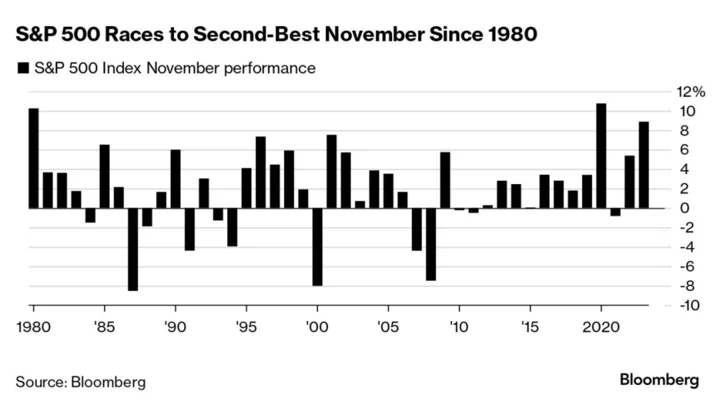The US stock market just posted its best month in almost a year and a half, and one of its best Novembers in decades, defying skeptics and fueling hopes for more gains to come.
The S&P 500 Index advanced 8.9% this month, for its second-best November since 1980, behind only the pandemic-fueled rebound in 2020, data compiled by Bloomberg show. The gauge is up around 19% in 2023 and snapped a three-month losing streak as investors looked past the possibility of a recession, geopolitical turmoil and soaring borrowing costs.
“Almost everyone was offsides coming into November,” said Ryan Detrick, chief market strategist at Carson Group. “So there’s still a big opportunity for traders to chase gains in December, too.”
The surge in stocks was part of a pan-markets rally triggered by a plunge in bond yields that accelerated as signs mounted that policymakers are managing to tame inflation without breaking the economy. The Nasdaq 100 Index gained about 11% in November — its strongest month since last year — as Big Tech dominated again. The index went the entire month without a single decline of 1% or more, and the last time that happened was in August 2021.
The bet now is that the Federal Reserve is done hiking rates and will start cutting by mid-2024. Traders will likely learn more on Friday when Fed Chair Jerome Powell has two appearances scheduled. It’s a pivotal moment for Wall Street as the end of the central bank’s tightening cycles has historically delivered double-digit returns for stocks.
Six Big Months
November traditionally kicks off the best six months of the year for the S&P 500, typically because stock buying by companies and pension plans picks up on Nov. 1. The tax-loss harvesting deadline for mutual funds usually is Oct. 31, not the end of the year the way it is for individual taxpayers.
Optimism that rates have peaked and the Fed will pivot to easing sparked an even bigger rally in riskier technology names. The ARK Innovation exchange-traded fund (ARKK), Cathie Wood’s flagship fund, soared in November.
Investors anticipating further gains have to contend with hefty concentration risk — as megacap tech shares have driven the bulk of the rally — inflation figures on Dec. 12 and the Fed’s next rate decision the following day. There’s also the historical tendency for tech stocks to slump at year-end. Since 1990, tech shares in the S&P 500 have declined on average in December, the only group to do so, data compiled by Citigroup Inc. show.
At least for this year, options traders are signaling they see little trouble ahead for the tech-heavy Nasdaq 100, judging by a measure of projected price swings — the Cboe NDX Volatility Index. The gauge is trading near the lowest level since before the pandemic.
As December begins, investors will be watching Powell on Friday for a better sense of the policy path. The Fed is expected to leave rates steady on Dec. 13, when officials will also release projections for the year ahead.
“The Fed fears that any signal from policymakers that a rate cut could be coming may cause another big rally in asset prices,” said Brooke May, managing partner at Evans May Wealth. “If that leads to a resurgence in inflation, Fed Chair Powell may strike a hawkish tone that may lead to a rise in volatility in the coming weeks.”









